Nakahara M. Geometry, Topology and Physics
Подождите немного. Документ загружается.


Then the Hamiltonian is
H =−
˙
ψ
i
i
2
ψ
i
− L =
i
2
ijk
B
i
ψ
j
ψ
k
. (12.131)
The Poincar´e one-form of this system is
θ =
i
2
ψ
i
dψ
i
. (12.132)
The corresponding symplectic two-form is
ω = dθ =
i
2
dψ
i
∧ dψ
i
(12.133)
from which we obtain the Poisson bracket
[ψ
j
, iψ
k
]
PB
= iδ
jk
. (12.134)
Quantization of the system is achieved by replacing this Poisson bracket by the
anti-commutation relation
{ψ
j
,ψ
k
}=δ
jk
. (12.135)
This anti-commutation relation is called the Clifford algebra in
3
.Letσ
i
be the
ith component of the Pauli matrices. It is easily verified from the observation
{σ
j
,σ
k
}=2δ
jk
that ψ
i
= σ
i
/
√
2 is the two-dimensional representation of the Clifford algebra.
It is known that the finite-dimensional irreducible representation of the Clifford
algebra is unique (modulo conjugate transformations). Thus, the Hilbert space of
this system turns out to be
=
2
. The Hamiltonian is rewritten in terms of the
Pauli matrices as
H =−
1
2
B · σ . (12.136)
This Hamiltonian is known as the Pauli Hamiltonian and describes a spin in a
magnetic field.
Similarly, the Clifford algebra defined in
2n
and
2n+1
acts on the Hilbert
space
=
2
n
.
12.9.2 Supersymmetric quantum mechanics in flat space
The Pauli Hamiltonian is made only of the spin coordinates ψ
i
and is independent
of the space coordinate x
k
. Accordingly, it cannot describe a travelling spin. Now
the Hamiltonian is modified so that the spin may move around the space. This can
be realized by adding a kinetic term to the Hamiltonian. Let us consider a spin in
d
and put B = 0 to obtain the Hamiltonian
L =
1
2
˙x
k
˙x
k
+
i
2
ψ
k
˙
ψ
k
. (12.137)
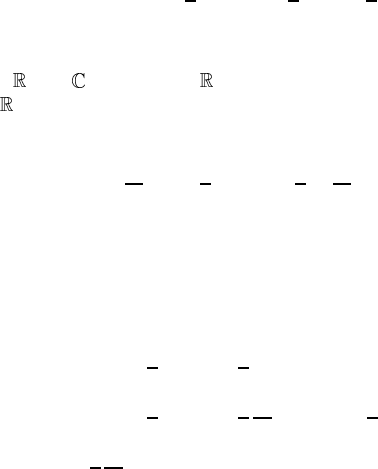
The coefficients of this Lagrangian have been chosen so that the system has a
supersymmetry defined later. The canonically conjugate momenta are p
k
=˙x
k
and π
k
=−iψ
k
/2, from which we obtain the Poisson brackets of the system
[x
j
, x
k
]
PB
=[p
j
, p
k
]
PB
= 0 [x
j
, p
k
]
PB
=[ψ
j
,ψ
k
]
PB
= δ
jk
.
It is easy to derive (anti)commutation relations from these Poisson brackets. The
canonical (anti)commutation relations are
[x
j
, x
k
]=[p
j
, p
k
]=0 [x
j
, p
k
]={ψ
j
,ψ
k
}=δ
jk
. (12.138)
The Hamiltonian is
H =˙x
j
p
j
−
˙
ψ
j
i
2
ψ
j
− L =
1
2
p
2
=−
1
2
(12.139)
where =
d
k=1
∂
2
k
is the d-dimensional Laplacian. The Hilbert space on which
H acts is L
2
(
d
) ⊗
2
n
,whereL
2
(
d
) stands for the set of square-integrable
functions in
d
and n ≡[d/2] is the integer part of d/2.
Variation of the Lagrangian yields
δL =˙x
j
d
dt
δx
j
+
i
2
δψ
j
˙
ψ
j
+
i
2
ψ
j
d
dt
δψ
j
.
Let us verify that the Lagrangian is invariant under the following supersymmetry
transformation
δx
j
= iψ
j
δψ
j
=− ˙x
j
(12.140)
where is an ‘infinitesimal’ real Grassmann constant. In fact,
δL = i ˙x
j
˙
ψ
j
−
i
2
˙x
j
˙
ψ
j
−
i
2
ψ
j
¨x
j
= i ˙x
j
˙
ψ
j
−
i
2
˙x
j
˙
ψ
j
−
i
2
d
dt
(ψ
j
˙x
j
) +
i
2
˙
ψ
j
˙x
j
=−
i
2
d
dt
(ψ
j
˙x
j
) (12.141)
and the action S =
Ldt is left invariant. The corresponding charge (the
generator) is called the supercharge and defined through the Noether’s theorem
as
4
Q ≡ ip
j
ψ
j
= iψ
j
p
j
= iψ
j
˙x
j
. (12.142)
Exercise 12.8. Show that
δx
j
=[x
j
,Q] (12.143)
δψ
j
={ψ
j
,Q}. (12.144)
4
Note that the mass of the particle is set to unity and hence we have p
j
=˙x
j
.
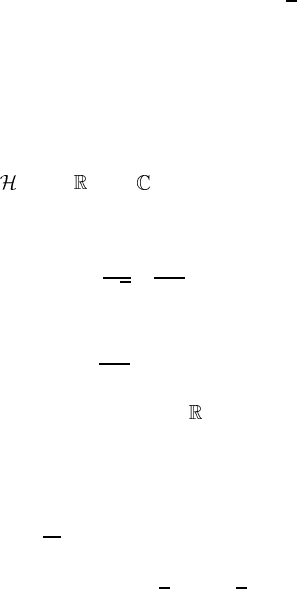
These equations show that Q is the generator of SUSY transformations.
Let us take d = 2n to be an even integer and quantize the system in the
following. We introduce the matrix representation ψ
j
= γ
j
/
√
2, which is the
generalization of the two-dimensional representation introduced in the previous
subsection. Here γ
j
are the d-dimensional Dirac matrices that satisfy the Clifford
algebra
{γ
j
,γ
k
}=2δ
ij
. (12.145)
The Hamiltonian acts on the Hilbert space
= L
2
(
2n
) ⊗
2
n
.
The supercharge takes the form, upon diagonalizing the coordinate,
Q = iψ
j
p
j
=
1
√
2
γ
j
∂
∂x
j
. (12.146)
The operator
/
∂ ≡ γ
j
∂
∂x
j
(12.147)
is nothing but the Dirac operator in Euclidean space
2n
and plays an important
role in the proof of the index theorem.
The hypercharge Q transforms in an interesting way under an SUSY
transformation (12.140)
δ Q = i(δψ
j
) ˙x
j
+i ψ
j
d
dt
δx
j
= i(− ˙x
j
) ˙x
j
+ iψ
j
(i
˙
ψ
j
)
=−i ˙x
j
˙x
j
+ ψ
j
˙
ψ
j
=−2i
1
2
˙x
j
˙x
j
+
i
2
ψ
j
˙
ψ
j
=−2iL. (12.148)
Namely, the variation of the supercharge under an infinitesimal SUSY
transformation is the Lagrangian!
We next consider the relation between the supercharge and the Hamiltonian
of the system. Let us consider successive SUSY transformations with Grassmann
parameters
1
and
2
. If a transformation with
1
is applied first and then
2
next,
we obtain
x
j
1
→ x
j
+ i
1
ψ
j
2
→ x
j
+ i(
1
+
2
)ψ
j
− i
1
2
˙x
j
ψ
j
1
→ ψ
j
−
1
˙x
j
2
→ ψ
j
− (
1
+
2
) ˙x
j
− i
1
2
˙
ψ
j
while if the order of the SUSY transformations is reversed,
x
j
→ x
j
+ i(
1
+
2
)ψ
j
− i
2
1
˙x
j
ψ
j
→ ψ
j
− (
1
+
2
) ˙x
j
− i
2
1
˙
ψ
j
.

We find, from these results, the commutation relation of the SUSY variations:
[δ
2
,δ
1
]=δ
2
δ
1
− δ
1
δ
2
=−2i
1
2
∂
∂t
. (12.149)
The observation that the commutation relation of two SUSY transformations
is a time derivative, i.e. the Hamiltonian, suggests that the anti-commutation
relation of the supercharge, the generator of the SUSY transformation, also yields
the Hamiltonian. In fact,
{Q, Q}=2Q
2
= 2(i p
j
ψ
j
)(i p
k
ψ
k
)
=−p
j
p
k
(ψ
j
ψ
k
+ ψ
k
ψ
j
) =−p
j
p
k
δ
jk
=−2H.
After all, the SUSY algebra reduces to
Q
2
=−H. (12.150)
Since Q is anti-Hermitian, the Hamiltonian is a Hermite operator with non-
negative spectrum.
In summary, we proved in equations (12.148) and (12.141) that
δ Q =−2iL δL =
1
2
dQ
dt
. (12.151)
If these equations are compared with the SUSY transformations (12.140) of
the coordinates x
j
and ψ
j
, we readily notice that the roles played by bosonic
quantities (x
j
and L) and the fermionic quantities (ψ
j
and Q) are interchanged.
Note that the variation of the supercharge Q in (12.151) is always a time derivative
of the Lagrangian L. This observation is crucial in constructing a SUSY-invariant
Lagrangian out of a supercharge Q.
12.9.3 Supersymmetric quantum mechanics in a general manifold
Let M be a Riemannian manifold with dim M = 2n. The Riemannian metric is
ds
2
= g
µν
dx
µ
dx
ν
and the inner product of two vectors X and Y with respect to this metric is denoted
as
X, Y =g
µν
X
µ
Y
ν
.
The vector ψ
µ
(t) belongs to TM
x(t )
at each instant of time t. Therefore,
ψ
µ
(t) obeys the ordinary transformation rule for a vector under the coordinate
transformation x
µ
→ x
µ
= x
µ
(x
ν
):
ψ
µ
→ ψ
µ
=
∂x
µ
∂x
ν
ψ
ν
. (12.152)

Then, under the SUSY transformation δ ≡ δ
, the coordinates transform as
δx
µ
=
∂x
µ
∂x
ν
δx
ν
=
∂x
µ
∂x
ν
iψ
ν
= iψ
µ
and
δψ
µ
=
∂
2
x
µ
∂x
ν
∂x
λ
δx
λ
ψ
ν
+
∂x
µ
∂x
ν
δψ
ν
=
∂
2
x
µ
∂x
ν
∂x
λ
iψ
λ
ψ
ν
+
∂x
µ
∂x
ν
(−i ˙x
ν
) =− ˙x
µ
where the anti-commutativity of Grassmann numbers has been used to obtain the
last equality. These transformation rules show that the SUSY transformation is
covariant under the coordinate transformation x
µ
→ x
µ
.
The supercharge Q introduced in the previous subsection should be
generalized on the manifold M as
Q = i˙x,ψ=ig
µν
(x ) ˙x
µ
ψ
ν
. (12.153)
The SUSY-invariant Lagrangian on M is constructed from the SUSY variation of
this Q as
δ Q = i∂
λ
g
µν
δx
λ
˙x
µ
ψ
ν
+ ig
µν
δ ˙x
µ
ψ
ν
+ ig
µν
˙x
µ
δψ
ν
= i∂
λ
g
µν
iψ
λ
˙x
µ
ψ
ν
+ ig
µν
(i
˙
ψ
µ
)ψ
ν
+ ig
µν
˙x
µ
(− ˙x
ν
)
=−2i
1
2
g
µν
˙x
µ
˙x
ν
+
i
2
g
µν
ψ
ν
˙
ψ
µ
−
i
2
˙x
µ
1
2
∂
λ
g
µν
− ∂
ν
g
µλ
− ∂
µ
g
λν
ψ
λ
ψ
ν
=−2i
1
2
g
µν
˙x
µ
˙x
ν
+
i
2
g
µν
ψ
ν
˙
ψ
µ
+
i
2
˙x
µ
g
λρ
ρ
µν
ψ
λ
ψ
ν
where
ν
λµ
=
1
2
g
νρ
∂
λ
g
ρµ
+ ∂
µ
g
λρ
− ∂
ρ
g
λν
is the Christoffel symbol associated with the Levi-Civita connection. Note the
symmetry
λ
µν
=
λ
νµ
. By comparing this δ Q with (12.151), we read off the
Lagrangian,
L =
1
2
g
µν
(x ) ˙x
µ
˙x
ν
+
i
2
g
µν
(x )ψ
µ
dψ
ν
dt
+˙x
λ
ν
λκ
(x )ψ
κ
=
1
2
˙x, ˙x+
i
2
2
ψ,
Dψ
Dt
3
. (12.154)
Here Dψ/Dt is the covariant derivative of ψ along the curve x(t).

Exercise 12.9. Show that the SUSY variation of the Lagrangian is proportional to
the time derivative of the supercharge,
δL =
1
2
dQ
dt
. (12.155)
The quantum version of the supercharge is
Q ∼ g
µν
p
µ
γ
ν
(12.156)
that is the Dirac operator
/
∂ on M.
Let us define some symbols that will be employed in the next section. The
connection one-form is
µ
ν
= dx
λ
µ
λν
(12.157)
while the Riemann curvature two-form is
µ
ν
= d
µ
ν
+
µ
σ
∧
σ
ν
. (12.158)
The Riemann curvature two-form is expanded in terms of dx
ρ
∧ dx
σ
to yield
µ
ν
=
1
2
R
µ
νρσ
dx
ρ
∧ dx
σ
(12.159)
the component of which is the ordinary Riemann curvature tensor. This
component is also written in terms of the connection ∇
µ
as
R
κ
λµν
=
2
dx
κ
, ∇
µ
∇
ν
∂
∂x
λ
−∇
ν
∇
µ
∂
∂x
λ
3
= ∂
µ
κ
νλ
− ∂
ν
κ
µλ
+
η
νλ
κ
µη
−
η
µλ
κ
νη
. (12.160)
12.10 Supersymmetric proof of index theorem
The proof of the index theorem in its simplest setting will be given in the present
section by making use of the supersymmetric quantum mechanics developed in
the previous section.
12.10.1 The index
Let us consider vector bundles E
±
π
−→ M, E = E
+
⊕E
−
and let be an elliptic
differential operator acting as
: (M, E
+
) → (M, E
−
).
It is possible, by using the fibre norm, to define the adjoint of
as
†
: (M, E
−
) → (M, E
+
).
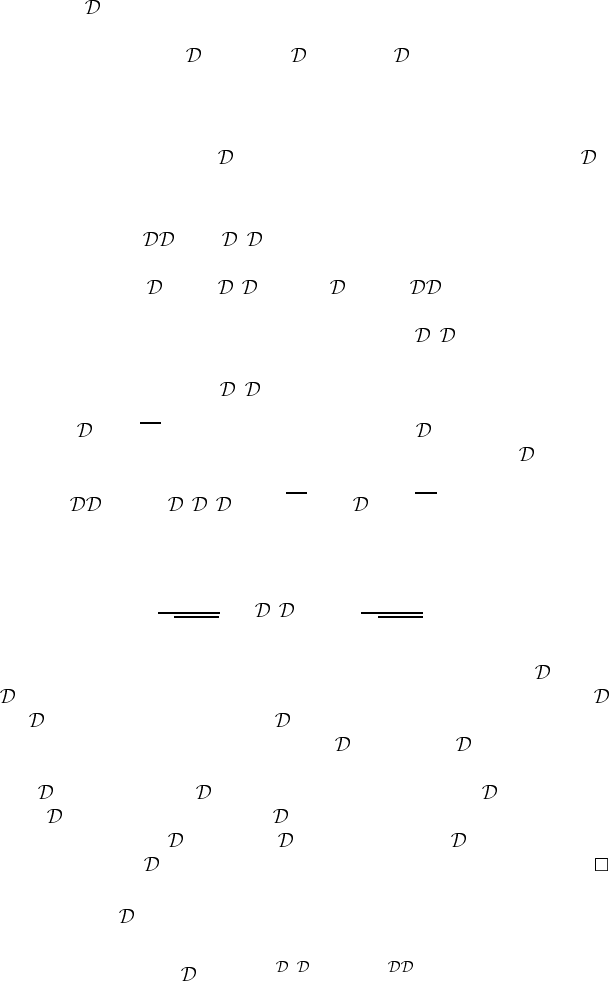
Assuming that is Fredholm, the index
Ind
= dim ker − dim ker
†
(12.161)
is well defined.
Theorem 12.4. The number ind
is invariant under a ‘small’ deformation of .
Proof.Note,first,that
†
and
†
are non-negative and, hence, it follows that
ker
= ker
†
ker
†
= ker
†
.
Let {φ
n
} be the orthonormal set of eigensections of
†
: (M, E
+
) →
(M, E
+
):
(
†
)φ
n
= λ
n
φ
n
.
Define ψ
n
≡ φ
n
/
√
λ
n
for λ
n
> 0, namely φ
n
∈ (ker )
⊥
. Then we find that
ψ
n
is an eigensection with the same eigenvalue λ
n
, namely ψ
n
∈ (ker
†
)
⊥
since
(
†
)ψ
n
= (
†
φ
n
)/
λ
n
= λ
n
φ
n
/
λ
n
= λ
n
ψ
n
.
Note also that {ψ
n
} is an orthonormal eigensection,
ψ
n
|ψ
m
=
1
√
λ
n
λ
m
φ
n
|
†
|φ
m
=
λ
m
√
λ
n
λ
m
δ
nm
= δ
nm
.
Thus, it follows that there is a natural isomorphism between (ker
)
⊥
and
(ker
†
)
⊥
. Note, however, that there exists no such isomorphism between ker
and ker
†
. Suppose N states in ker obtain non-vanishing eigenvalues as a
result of a small perturbation of the operator
and dim ker decreases by N.
Then it follows from this observation that the same number of states must also
leave ker
†
.Otherwise(ker )
⊥
is no longer isomorphic to (ker
†
)
⊥
. Similary,
if dim ker
increases by N ,dimker
†
must also increase by N to keep the
pairing properties of (ker
)
⊥
and (ker
†
)
⊥
. Therefore, ind is invariant under
small perturbations of
.
Theorem 12.5. Let be a Fredholm differential operator. Then its index is given
by
ind
= Tr e
−β
†
− Tr e
−β
†
(12.162)
where β>0 is a real constant. In fact, the index is independent of β.
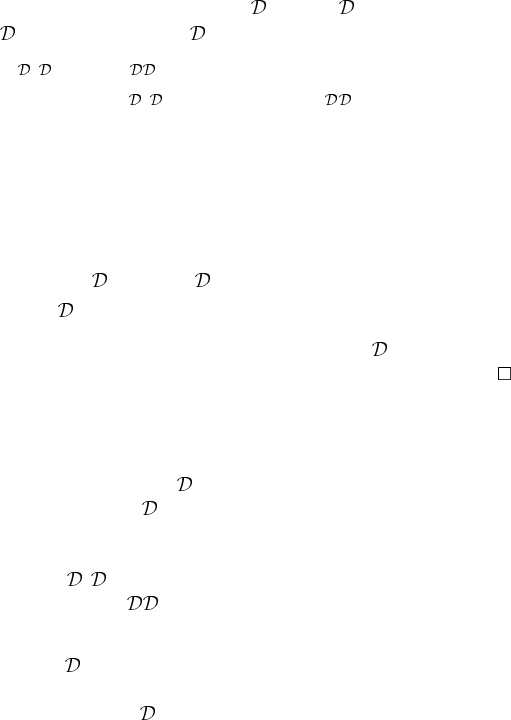
Proof. The traces in (12.162) are over {φ
n
} and {ψ
n
}, respectively. Let {φ
0
i
}
and {ψ
0
i
} be orthonormal eigensections of ker and ker
†
, respectively, and
1 ≤ i ≤ dim ker
and 1 ≤ j ≤ dim ker
†
. Then it follows that
Tr e
−β
†
− Tr e
−β
†
=
λ
n
=0
φ
n
|e
−β
†
|φ
n
−
λ
n
=0
ψ
n
|e
−β
†
|ψ
n
+
i
φ
0
i
|φ
0
i
−
j
ψ
0
j
|ψ
0
j
=
λ
n
=0
e
−βλ
n
(
φ
n
|φ
n
−ψ
n
|ψ
n
)
+
i
1 −
j
1
= dim ker
− dim ker
†
= ind .
Since the summations over i and j are independent of β,ind
thus defined is
independent of β.
The trace that appears in theorem 12.5 is identified with the heat kernel.
Let E = E
+
⊕ E
−
and define a differential operator acting on E by
5
(cf
equation (12.79))
iQ ≡
0
†
0
: E → E. (12.163)
Moreover, define a ‘Hamiltonian’ and a matrix by
H = (iQ)
2
=
†
0
0
†
=
10
0 −1
. (12.164)
Since Q thus defined is anti-Hermitian, the operator H is Hermite and non-
negative. The index of
is rewritten in a compact form by making use of
as
ind
= Tr e
−β H
. (12.165)
Let M be a spin manifold, for which the second Stiefel–Whitney class
w
2
(M) is trivial. Accordingly, the SO(k) principal bundle over M may be lifted
to the SPIN(k) principal bundle as
SO(k) → SPIN(k).
↓ π
M
Let E = (M) be this spin bundle. Then, associated with (M) is a Clifford
algebra {γ
µ
,γ
ν
}=2δ
µν
. Let us define the chirality operator
γ
2n+1
≡ i
n
γ
1
γ
2
...γ
2n
. (12.166)
5
The operator Q will be identified with the supercharge later.
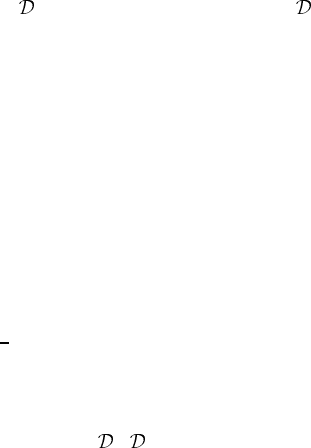
It follows from γ
2
2n+1
= 1 that the eigenvalues of γ
2n+1
are restricted to be ±1,
which we call chirality.
Exercise 12.10. Use the Clifford algebra to show that
γ
2
2n+1
= 1 {γ
µ
,γ
2n+1
}=0.
The set of sections (M,)for an even k is not an irreducible representation
of SPIN(k) but can be decomposed into two subspaces according to the chirality
as
(M,) = (M,
+
) ⊕ (M,
−
) (12.167)
where ψ
±
∈ (M,
±
) satisfy γ
2n+1
ψ
±
=±ψ
±
. We assign the fermion
number F = 0 to sections in (M,
+
) while F = 1 for those in (M,
−
).
Then the defined in (12.164) can be written as
= (−1)
F
. (12.168)
It is clear that the operator Q flips the chirality and hence {Q,}=0.
Let Q be the Dirac operator on M and let = γ
2n+1
. In fact, it follows from
exercise 12.11 that {Q,γ
2n+1
}=0andγ
2n+1
is identified with (−1)
F
.When
is diagonalized as in (12.164), the chirality eigensections are expressed as
6
ψ
+
=
ψ
+
0
ψ
−
=
0
ψ
−
. (12.169)
It should be then clear that
: (M,
+
) → (M,
−
) and
†
: (M,
−
) →
(M,
+
) are identified with D and D
†
, respectively, in (12.79). Accordingly,
the index of the Dirac operator is defined as
ind Q = dim ker D − dim ker D
†
. (12.170)
Physicists often call the sections in ker D and ker D
†
zero modes. Then, the
index of the Dirac operator is the difference between the number of positive and
negative chirality zero modes. This index has a path integral expression as we see
in the next subsection.
12.10.2 Path integral and index theorem
Let us consider a Dirac operator Q on a 2n-dimensional spin manifold M.We
employ Euclidean time (t →−it) from now on.
Let H = (iQ)
2
=
1
2
g
µν
p
µ
p
ν
be the Hamiltonian corresonding to Q.Then
the index of the Dirac operator has a path integral expression
ind Q = Tr e
−β H
= Tr(−1)
F
e
−β H
=
PBC
x ψ e
−
β
0
dtL
(12.171)
6
Note the slight abuse of notations. The symbols ψ
±
have been used to denote sections in (M, S)
as well as those in (M,
±
).

where the Lagrangian L has been introduced in (12.154),
L =
1
2
g
µν
(x ) ˙x
µ
˙x
ν
+
1
2
g
µν
(x )ψ
µ
Dψ
ν
Dt
(12.172)
and PBC stands for the boundary condition in which the path integral is over
functions satisfying a periodic boundary condition over [0,β]. The factor (−1)
F
disappears if the anti-periodic boundary condition for the fermionic variables is
changed into a periodic one. This can be seen from the following observation. In
the path integral formalism, the trace with (−1)
F
is (see section 1.5)
tr(−1)
F
e
−β H
=
n
n|(−1)
F
e
−β H
|n
=
dθ
∗
dθ−θ |(−1)
F
e
−β H
|θe
−θ
∗
θ
(12.173)
where F = c
†
c is the Fermion number operator. By noting that
|θ=|0+|1θ(−1)
F
|θ=|0−|1θ =|−θ
this integral is cast into the form
dθ
∗
dθθ |e
−β H
|θe
−θ
∗
θ
. (12.174)
Thus, by eliminating (−1)
F
, we have to change the boundary condition to a
periodic one.
This path integral is evaluated in the rest of this section to show that it reduces
to a topological index obtained from the Dirac
ˆ
A-genus.
The SUSY transformation in Euclidean time is obtained by the replacement
t →−it in (12.140) as
δx
µ
= iψ
µ
δψ
µ
=−i ˙x
µ
.
As was shown in the previous subsection, the index is independent of β and,
hence, we may consider the limit β ↓ 0 in computing the trace. By rescaling the
time parameter as t = βs, we cast the action into the form
β
0
dt
1
2
g
µν
(x ) ˙x
µ
˙x
ν
+
1
2
g
µν
(x )ψ
µ
Dψ
ν
Dt
=
1
0
ds
1
β
1
2
g
µν
(x )
dx
µ
ds
dx
ν
ds
+
1
2
g
µν
(x )ψ
µ
Dψ
ν
Ds
. (12.175)
Thus, any path with ˙x = 0 has an exponentially small contribution to the path
integral in the limit β ↓ 0. Accordingly, the contributions to the path integral
come only from paths x (t) = constant in this limit. Clearly, these paths satisfy
the periodic boundary condition.
